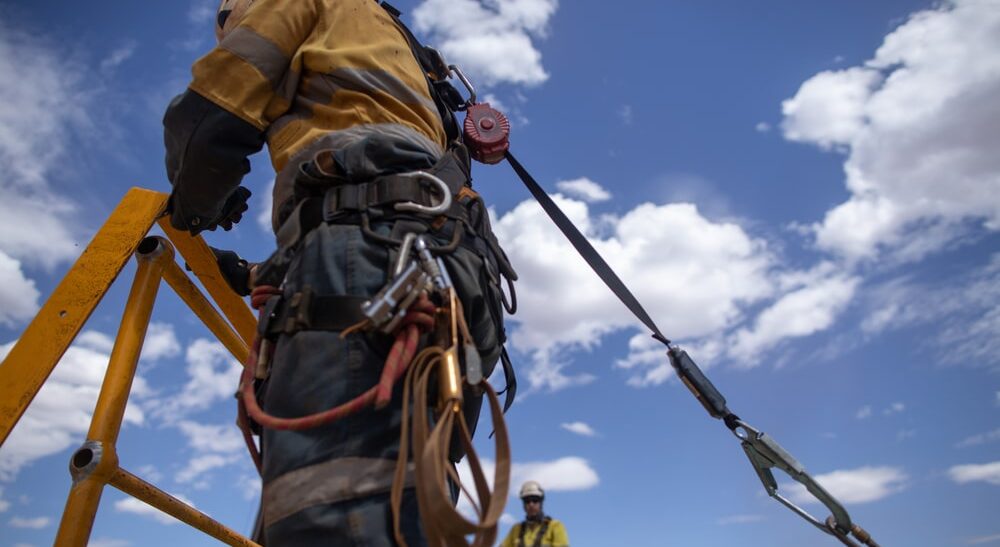Did you know that falls are the most common cause of serious work-related injuries and death? A fall protection training program is crucial to keep employees safe in all industries operating in hazardous situations. Here’s what you can expect from fall protection training and an overview of the knowledge you’ll gain.
Identify and Recognize the Types of Fall Hazards
Some of the most common types of fall hazards include:
- Ladders
- Roofs
- Scaffolds
- The top of equipment
- The top of work trucks
- Elevated platforms
- Unguarded work areas
- Stairs
- Ramps
- Dock boards
Most fall hazards are foreseeable and can be recognized with a trained eye. A fall protection course teaches workers how to identify where a fall is likely to occur. This is especially beneficial for workers who frequently visit new sites or deliver products to clients. Regardless of whether they’ve been to the workplace before, employees can recognize a hazardous area and protect themselves accordingly.
The Correct Procedures for Handling Personal Fall Protection Systems
Workers will be trained on how to correctly install, operate, and disassemble personal fall protection equipment such as (but not limited to):
- Portable guardrails
- Safety net systems
- Mobile ladder stands
- Mobile platforms
Fall protection training also specifies the limitations of these devices and teaches workers how misuse can lead to injury or death.
Understand the Plans and Procedures to Prevent Falls
Employees will understand how the procedures established for each fall hazard will protect them from injury or death. While solid plans and procedures prevent workplace fall hazards, employees won’t know these plans exist without training and how they protect them from harm. The goal is to instill the knowledge and confidence that workers need to do their jobs safely.
The Anatomy of a Fall
This may sound peculiar, but fall protection training covers the anatomy of a fall. It’s not the fall itself that causes injury or death but the sudden force of hitting the surface below. Employees will understand how many seconds it typically takes to be aware of a fall and how quickly the body reacts. Our fall protection course includes fall arrest, which involves safely stopping a person already falling.
Who Needs Fall Protection Training?
In the past, fall protection plans and procedures focused primarily on the construction industry. However, this has extended to general industries, including (but not limited to) electricians, plumbing, shipping and receiving, manufacturing, and any workplace in high-hazard environments. Employers must ensure workers are trained in fall protection if there is a fall risk present or a history of fall injury or death at the workplace.
The blue-collar worker. Industrious, hard-working, and considered by many to be the backbone of our economy. Many people don’t realize the type of work involved in these jobs and career fields. Aside from the hard labour, blue-collar workers often work in hazardous conditions as well. Everything from confined spaces all the way to elevated heights encompasses this line of work.
For this reason, we at AIP Safety offer a fall protection training program in Calgary. Focusing on worker education, this course aims to inform everyone from electricians and plumbers to labourers and steel workers on the best practices for elevated workplace safety. Keep reading to learn more.
Why AIP Safety?
At AIP Safety, we operate with Health, Safety and Environmental experts, beginning at the local level and going all the way to the international level.
Our fall protection training program offers clear-cut advice, practical guidance, and industry knowledge of best practices in fall arrest education. We merge versatility with sensible expertise, allowing us to produce and deliver a training course of this calibre.
Additionally, we deliver training in many locations; everything from your work office environment to in-house training programs at our facility are included.
We are organized and flexible, which allows us to exceed your expectations and accommodate your schedule.
What to Expect From Our Fall Protection Training Program
To work in such environments, workers must be trained in fall protection equipment as decreed by the OH&S Code of Alberta. Our course is a 4-hour program designed to educate and inform the everyday blue-collar worker in the planning, usage, and application of Fall Protection systems.
What you’ll learn:
- Best practices for safety regulations
- How to properly examine and inspect your harness, lanyard, and other fall protection equipment
- Proper equipment selection, examination, and upkeep
- The difference between fall restraint vs. fall arrest
- The importance of Anchor Points and Anchor Systems
- The necessity of a Pro-Active Safety mindset and attitude
- How to safely use the equipment and systems
Final Thoughts
Fall arrest saves lives. Using the right equipment for the job, knowing what to do should an accident occur, and competently implementing this knowledge allow workers to return home safely after a hard and honest day’s work. As such, AIP’s fall protection training program is a course you can't miss if any part of your work scope encompasses heights.
At AIP Safety, we are committed to providing quality training courses that educate and inform workers about the best practices for workplace safety. If you are curious to learn more about our programs, contact us today.
Frequently Asked Questions
Who is required to take Fall Protection Training?
As mandated by the OH&S Code of Alberta, any worker performing tasks at elevated heights, whether on a temporary or permanent worksite, must complete fall protection training. This includes construction workers, electricians, plumbers, steel workers, and warehouse employees.
How long is the Fall Protection certification valid?
Our fall protection certification is valid for three years. While annual renewal is not required, refresher courses are recommended to ensure workers stay updated on safety protocols and best practices.
What is the difference between Fall Restraint and Fall Arrest?
- Fall Restraint: Prevents a worker from reaching a fall hazard (e.g., using a lanyard to restrict movement).
- Fall Arrest: Stops a fall after it occurs, using safety equipment like harnesses and anchor systems to minimize injury.
Can I take the Fall Protection Training Course online?
AIP Safety offers a blended learning option where part of the course is completed online, followed by an in-person practical assessment at an AIP location. This flexible format allows workers to complete training efficiently while meeting certification requirements.

